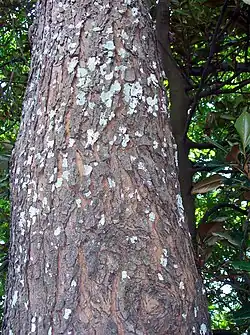| Miva mahogany | |
|---|---|
 | |
| Miva Mahogany at the Royal Botanic Gardens Sydney | |
| Scientific classification | |
| Kingdom: | Plantae |
| Clade: | Tracheophytes |
| Clade: | Angiosperms |
| Clade: | Eudicots |
| Clade: | Rosids |
| Order: | Sapindales |
| Family: | Meliaceae |
| Genus: | Dysoxylum |
| Species: | |
| Subspecies: | D. m. subsp. molle |
| Trinomial name | |
| Dysoxylum mollissimum subsp. molle | |
| Synonyms | |
Dysoxylum mollissimum subsp. molle, the red bean or Miva mahogany, is a rainforest tree in the family Meliaceae.[3] It occurs in tropical, sub-tropical and littoral rainforests in eastern Australia, as far southwards as north-eastern New South Wales. Also occurs in Malesia and the south-western Pacific Islands.[4] In Australia it is distributed from the Bellinger River in New South Wales in the south, to the wet tropics of north-eastern Queensland.[3][4] The specific epithet mollissimum is from the Latin, meaning "very soft", describing the soft hairy leaflets. A signposted red bean tree may be seen near the car park of Victoria Park Nature Reserve in north-eastern New South Wales.
Description
It is a large and impressive tree, up to 35 metres (115 ft) tall and a trunk diameter of 120 cm (47 in). It is usually buttressed or flanged at the base. The trunk is scaly and rough, grey or brown in colour. Freshly cut bark has an onion type scent.[5]
Leaves
Leaflets are usually opposite on the stem, without serrations, and distinctly asymmetrical at the leaf base. Leaflets are 6 to 15 cm (2.4 to 5.9 in) long and 2 to 5 cm (0.79 to 1.97 in) wide,[3] and are mid green above, paler below, and sometimes softly hairy under the leaf. True leaves are 30 to 60 cm (12 to 24 in) long, pinnate. Leaf stem swollen where joining the larger branch. Leaf venation is evident above and below, but raised and more noticeable below. Net veins easily seen. Veins creamy green, contrasting with the darker leaf colour.
Flowers and fruit
White flowers form on panicles from January to July. The fruit is a fawnish brown capsule, around 2 cm (0.79 in) in diameter. There is one reddish brown seed in each of the one to five cells. The fruit ripens between November and March. The fruit is bird attracting.[6] Fresh seed is advised for regeneration.
Conservation
This species has been assessed by the IUCN and the Queensland Department of Environment and Science as least concern.[1][2]
Timber
The tree produces a well regarded mahogany timber, suited to cabinet work, carving and boat building. It is reddish brown and easily worked.[5] Sapwood is creamy pink[7] and not resistant to termites.[6] There is concern of inhaling wood dust from this tree.[8]

References
- 1 2 "Species profile—Dysoxylum mollissimum subsp. molle". Queensland Department of Environment and Science. Queensland Government. 2022. Retrieved 5 January 2024.
- 1 2 Liu, D.; Botanic Gardens Conservation International (BGCI) & IUCN SSC Global Tree Specialist Group (2019). "Dysoxylum mollissimum". IUCN Red List of Threatened Species. 2019: e.T147647313A147647315. doi:10.2305/IUCN.UK.2019-2.RLTS.T147647313A147647315.en. Retrieved 5 July 2021.
- 1 2 3 Taylor, M. J.; Harden, G. J. (2002). "Dysoxylum mollissimum subsp. molle – New South Wales Flora Online". PlantNET – The Plant Information Network System. 2.0. Sydney, Australia: The Royal Botanic Gardens and Domain Trust. Retrieved 13 Mar 2013.
- 1 2 F.A.Zich; B.P.M.Hyland; T.Whiffen; R.A.Kerrigan (2020). "Dysoxylum mollissimum subsp. molle". Australian Tropical Rainforest Plants Edition 8 (RFK8). Centre for Australian National Biodiversity Research (CANBR), Australian Government. Retrieved 6 June 2021.
- 1 2 Floyd, A. G. (2008). Rainforest Trees of Mainland South-eastern Australia (2nd, Revised ed.). Lismore, New South Wales: Terania Rainforest Publishing. p. 220. ISBN 978-0-958943-67-3. Retrieved 2010-02-01.
- 1 2 "Cedarworks - Red Bean". Archived from the original on 2010-07-28. Retrieved 2010-02-01.
- ↑ "Miva mahogany (Queensland Primary Industries and Fisheries)". Archived from the original on 2009-12-06. Retrieved 2010-02-01.
- ↑ "Timber Health Hazards". U-Beaut Enterprises. 2014.
